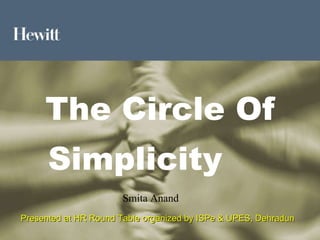
The Circle Of Simplicity
- 1. Transforming Your Business Hewitt Associates The Circle Of Simplicity Presented at HR Round Table organized by ISPe & UPES, Dehradun Smita Anand
- 5. The Value Creation Paradigm Distribution of wealth must be preceded by creation of wealth Organizations require social legitimacy/credibility to be attractive It’s a myth that old organizations cannot really change Organizations first create value for those they serve and then for those who own it It’s a myth that organizational efficiencies invariably decrease when change is effected
- 9. Value Creation - Define Performance Philosophy First Variable Enterprise-Business Mix Enterprise-wide Consensus Performance Focus Financial Results Business Unit Driven Customer Process Business Unit Chosen Capability Perception Usage Reward&Recognition Developmental Rater Constitution Single Rater Multi-Rater Unit of Measurement Individual Team Degree of Differentiation No Differentiation High Performers Low Performers Frequency-Depth Mix Project-based Review Quarterly Review with Lower Depth Annual Review with Greater Depth Options
- 12. Aligning talent strategy to business Business Strategy Initial Talent Strategy Questions Focused Talent Strategy Questions Grow Revenues by 10% over FY02 through M&A’s and JV’s Sourcing Do you have the necessary talent inside the company, or will you look outside ? Assessing What goals will the leadership team have to accomplish? Developing What skill sets and competencies are critical for success? Compensating What are the right target reward levels given this new challenge? Do these skills exist in-house and with whom? Where these skills are missing, do we build internally or seek externally? For whom is this an ideal developmental assignment? How will we measure our success developing these skills and assess the need for other skills?
- 13. Manage talent proactively Who are your essential people? Crucial Employees Identification of the critical talent pool within the organisation is imperative to survive the “War For Talent”
- 14. Manage talent proactively What should we do with our most important people? Plan Engage Develop Deploy Reward By identifying the right levers for change within each employee group, we can adapt and orient talent to the changing business needs Critical Important Low Priority Optimise Productivity Link Performance to Rewards Optimise Workforce Recruit/ Train/ Mentor Succession Planning Knowledge Workers Middle Management Skilled Workers Less- Skilled Workers Top Executives
- 15. Align leadership to business strategy A firm’s Leadership strategy must align with its business strategy and the change required in their environment Growth Return Transformational Change Leadership systems reinforcing: Vision, Speed, Aggressiveness, Risk-taking, Managing Change, Driving Results Leadership systems reinforcing: Speed, Aggressiveness, Process Management, Risk-taking, Planning, Task Focus Leadership systems reinforcing: Vision, Decision-making, Financial Acumen, Managing Change, Risk Management, Cost Control Leadership systems reinforcing: Risk Management, Process Management, Financial Acumen, Cost Control, Rule Orientation, Task Focus Transactional Change
- 17. Building Commitment- Providing Real-World Road Maps of Opportunities High-Level View of Next Career Move Architect 3–People 2–Sales 1–Service 1–Knowledge 2–Culture Architect On a higher complexity engagement 3–People 2–Sales 1–Service 1–Knowledge 2–Culture Technical Strategist On an equal or lower complexity engagement 2–People 1–Sales 2–Service 1–Knowledge 2–Culture Project Manager On an equal or lower complexity engagement 1–People 3–Sales 1–Service 2–Knowledge 3–Culture Note: Numbers indicate mega -process focus for each role (1=highest significance) Designer 3–People 3–Sales 1–Service 1–Knowledge 2–Culture On a higher complexity engagement Knowledge Manager On an equal or lower complexity engagement 4–People 3–Sales 2–Service 1–Knowledge 5–Culture Team Leader On a higher complexity engagement 1–People 2–Sales 1–Service 1–Knowledge 3–Culture You Are Here
- 18. Is There Training Without ROI Analysis? Sample Training ROI Analysis Tool
- 19. Is There Training Without ROI Analysis? Sample Training ROI Analysis Tool High-Level Findings
- 20. Aligning Your Workforce With Your Change Direction Fwd Rew Exploring Creating Home
- 22. In summary, Five Lessons on What needs To Change 1 Speed of change 2 Recognizing full impact of technology & customers 3 ROI on people - key measure for HR effectiveness 4 Distribution of wealth-competitive fixed,attractive variable 5 Drive organizational performance
Hinweis der Redaktion
- You also are right to want to change your culture to reflect changed organizational goals. Companies with flexible, adaptive culture tend to perform better. Nonadaptive/Other companies Bureaucratic, people are reactive, risk averse, not creative, emphasis on control, information doe not flow freely through organization
- Overview Strategy Positioning Value-Based Management Capability Mapping Values & Competencies Organization Culture Brand Talent Strategy Final Thoughts
- Overview Turning Ideas into Action Focus Accountability Practicality Capability Highlights Change Management Staffing/Selection Opportunities/Development Time/Work/Life Programs Compensation/Total Rewards
- Overview Turning Ideas into Action Focus Accountability Practicality Capability Highlights Change Management Staffing/Selection Opportunities/Development Time/Work/Life Programs Compensation/Total Rewards
